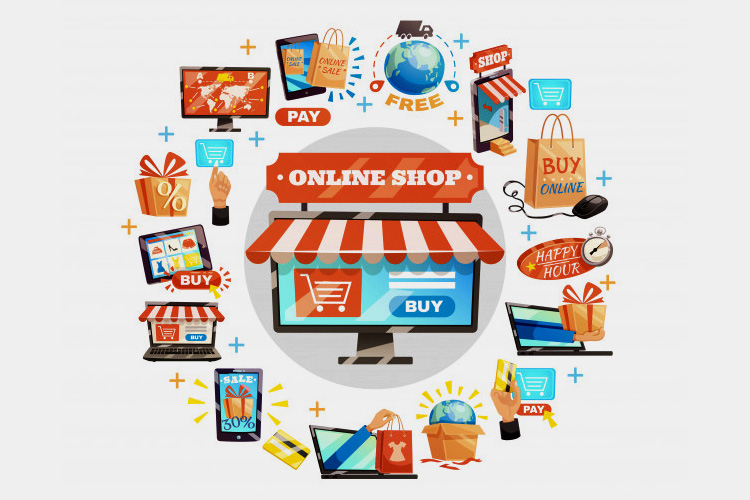How to Sell Online

Are you planning on selling your products online anytime soon? Well, now is the best time to become an ecommerce seller. The world of online shopping has boomed in the past few years, and online selling had indeed become profitable than ever. Ecommerce retailers can also make use of multichannel listing tools and multichannel selling software to post about their products on multiple platforms such as Amazon, eBay, and so on. You can also employ real-time inventory sync tools for your inventory management, order management tools to take care of your orders, dropshipping automation software to make dropshipping smoother, and the like.
The one question that ecommerce sellers could be plagued by is that of how to start selling online. There are indeed so many factors to take care of, and numerous things to remember before you get ready to showcase your products on digital platforms. Research states that the sales from ecommerce website came up to $2,012,096 in 2019. The revenue is expected to display an annual growth rate of 8%, thereby bringing the market volume up to $2,734,414 in 2023.
It’s clear, therefore, that there’s no better time to start selling online than the present. Let’s take a look at the few steps that will help you in selling online in 2020 and beyond.
What to Remember When Selling Online
Whether you’re someone who has had an online business for quite a while, or you’re just starting out, certain points act as the best guiding material to help your ecommerce business become successful. Here are some things to keep in mind when you sell online:
Choosing What to Sell
Just because you have the dream of owning an ecommerce store doesn’t mean you necessarily know what you want to sell. Perhaps you’re still exploring and trying to figure out which category of products will bring in the most profit. If you haven’t decided yet, you might want to choose one of the broader categories, and then narrow it down to a niche.
Niching down helps your ecommerce store in standing out, and helps you shine bright among the tough competition. For example, if you start selling kitchen supplies, you’re bound to face a lot of competition from the other ecommerce stores that have already been in this field for long. However, if you niche it down to coffee makers, the attraction of your brand will increase, and you will be able to create a niche and name for yourself in the ecommerce marketplace.
Selecting the Domain Name
A domain name or URL is what a customer would type in as a web address on their browser in order to find your website. One wise advice to follow is to name your business while choosing a domain name, because that way you will be able to pick a domain name that reflects your business, and avoid issues such as clashing domain names with other businesses, and so on.
Selecting the appropriate domain name is extremely crucial. You should remember to pick one that’s clear, short, and memorable. In case the name of your business doesn’t already have the keywords related to your brand and products, you should definitely make sure to include them in your domain name so that the SEO purpose is taken care of.
Another thing to note down is that your domain name should be simple enough to say out loud. If you’re having a discussion with someone about your domain name, it shouldn’t be so confusing that you have to spell it out. Stay away from hyphens, words that sound similar to other words, the mix-up of digits with spelled-out numbers, and so on. People prefer simpler domain names nowadays, and it’s better to give them something that isn’t too ambiguous or awkward.
Building Your Ecommerce Store
As a person who wishes to start an ecommerce store, you could be apprehensive about creating your website because of all the misconceptions that have been fed to us regarding the necessity of having to know how to code in order to make a website. Well, guess what? That’s not true at all. Nowadays, you can develop a beautiful and efficient website without knowing a word about coding.
All you need is a competent ecommerce solution that can assist you in building your store, adding products, creating a checkout, and helping with things such as order management, inventory management, shipping solution, dropshipping, and so on. Therefore, choosing the right platform becomes extremely imperative so that you don’t end up spending more on individual features, and can rather aid your business in growing without fretting over software limitations.
Receiving Payments
Receiving online payments isn’t a tough task at all. You can either go for the traditional way of opening a merchant account, or opt for a payment processor such as PayPal, Stripe, etc. These are extremely easy to set up, and most of these already come integrated with the major ecommerce software available in the market.
Credit cards do serve as the most popular payment method online, but there are other payment providers as well, such as the digital wallet solutions provided by services like Amazon Pay, Google Pay, Apple Pay, and so on. These help the customers who don’t prefer to use their credit cards while shopping online.
These services also help the customers in saving their payment methods that can be used on multiple websites. In case you currently own a brick-and-mortar store, the POS processor you have at the moment can provide you with an extension that enables you to use it as a medium to accept payments.
Selecting Methods of Shipping
Shipping is evidently a big part of any ecommerce business. There are several tools and software available that can help you with regards to managing your shipping. You will also have to decide the appropriate rate to charge your customers for shipping.
There are certain ecommerce stores that provide free shipping, but that also means absorbing the cost. Therefore, you will have to start looking into the real-time rates that are provided by the shipping carrier you use. Real-times rates are calculated while a customer keeps adding things to their cart, ensuring that neither are they overcharged nor do you end up losing money in shipping.
Promoting Your Ecommerce Store
The most integral part of having an ecommerce store and selling things online is knowing how to promote and market your company and brand. Having social media accounts for your store is definitely a must. Your brand should have a page on all the popular digital platforms such as Instagram, Facebook, Twitter, etc.
Sending newsletters through email is a crucial thing to do as well. You can also go for customized newsletters, because customers always feel more special when they know their favorite store is looking after their needs. Make sure to not make these newsletters bland and just full of text. Add color and different fonts to make it visually appealing in addition to being informative. Provide them with updates related to new launches, upcoming sales and offers, and the like.
Your ecommerce store also needs to be SEO-optimized so that more and more people can discover it while browsing the internet. Therefore, ensure to include all the relevant keywords in different parts and pages of your website. Creating a blog on your website helps, too, so that people can track down your website through those blog posts that have the necessary keywords.
Write For Us
Gain multichannel inventory visibility and control with eChannelHub
Learn more about eChannelHub with a free demo, tailored for your unique retail business.
Request A DemoRequest a Demo
Gain multichannel inventory visibility and control with eChannelHub
Learn more about eChannelHub with a free demo, tailored for your unique online business




